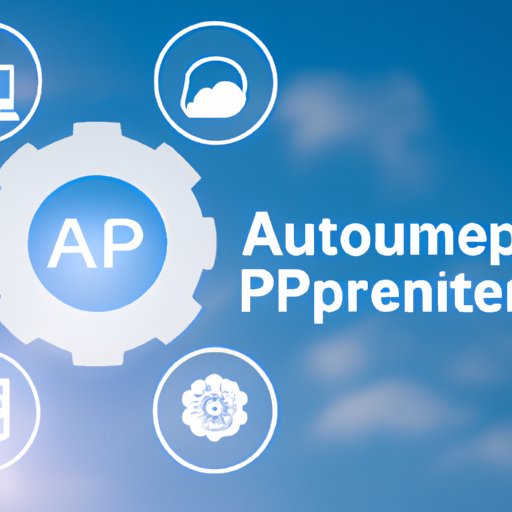Introduction
Accounts payable (AP) automation is a process that streamlines business processes by automating manual accounts payable tasks. By using advanced software solutions, AP automation can improve efficiency, reduce labor costs, and increase accuracy and compliance. In this article, we will explore the benefits of AP automation, understand its role in streamlining business processes, learn how to implement it, and explore the technologies used in AP automation.

Exploring the Benefits of AP Automation
AP automation has many advantages for businesses. According to a survey conducted by the Aberdeen Group, 87% of organizations that have implemented AP automation reported improved efficiency, 81% saw cost savings, and 90% experienced increased accuracy and compliance. Additionally, AP automation can help businesses reduce errors, save time, and improve customer service.

Understanding the Role of AP Automation in Streamlining Business Processes
AP automation plays an important role in streamlining business processes. It eliminates manual processes, such as data entry and invoice processing, which can be time consuming and prone to errors. By automating these tasks, businesses can save time and money, while also improving accuracy and compliance.
How AP Automation Improves Efficiency
AP automation can improve efficiency in several ways. First, it automates manual processes, such as data entry and invoice processing, which can be time consuming and prone to errors. Automating these tasks can save time and money, while also improving accuracy and compliance. Additionally, AP automation can reduce labor costs by eliminating the need for manual labor. Finally, it can improve customer service by providing timely and accurate information.
A Guide to Implementing AP Automation
Implementing AP automation can be a complex process. Here are some steps to get you started:
- Assess Your Current System: Assessing your current system will help you identify areas where automation can improve efficiency and reduce costs.
- Develop a Plan of Action: Developing a plan of action will help you identify the steps you need to take to implement AP automation.
- Select the Right Software: Selecting the right software is essential for successful implementation. Consider factors such as cost, features, scalability, and ease of use.
- Train Employees: Training employees on how to use the new system is essential for successful implementation. Make sure they understand the features and functions of the software.
- Monitor and Refine the System: Once the system is up and running, monitor and refine it to ensure it is working optimally. Consider factors such as accuracy, speed, and cost savings.

A Comprehensive Overview of AP Automation Technology
The technology used in AP automation varies depending on the needs of the organization. Traditional approaches involve manual data entry, while more advanced solutions use cloud-based software and AI-powered automation. Let’s take a closer look at each type of technology.
Traditional Approaches
Traditional approaches to AP automation involve manual data entry. This requires a significant amount of time and effort, and is prone to errors. Additionally, manual processes can lead to delays in payment, resulting in unhappy customers.
Cloud-Based Solutions
Cloud-based solutions offer a more efficient way to manage AP. These solutions allow businesses to access their data from any location, and provide automated features such as invoice processing and payment tracking. Additionally, cloud-based solutions are typically more secure than traditional solutions.
AI-Powered Automation
AI-powered automation is the most advanced form of AP automation. AI-powered solutions can automate complex tasks, such as invoice processing and payment tracking, while also reducing errors and improving accuracy. Additionally, AI-powered solutions can provide predictive analytics, allowing businesses to make informed decisions about their finances.
Conclusion
AP automation is an effective way to streamline business processes and improve efficiency. It can reduce labor costs, increase accuracy and compliance, and improve customer service. Additionally, by implementing cloud-based solutions and AI-powered automation, businesses can further optimize their AP processes. For more information on AP automation, contact a professional today.
(Note: Is this article not meeting your expectations? Do you have knowledge or insights to share? Unlock new opportunities and expand your reach by joining our authors team. Click Registration to join us and share your expertise with our readers.)
